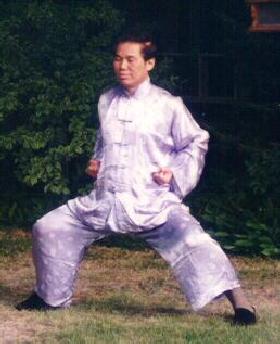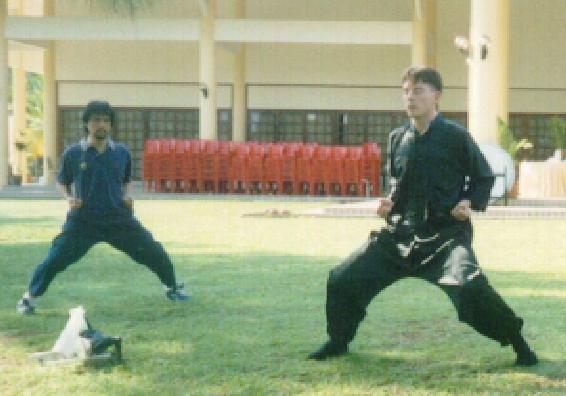RELAXING AT THE HORSE-RIDING STANCE

Grandmaster Wong demonstrating the Horse-Riding Stance. To be relaxed is the most important factor in stance training.
The following discussion is reproduced from the thread Dispelling Ignorance and Restoring the Glory of Kungfu started in the Shaolin Wahnam Discussion Forum on 15th April 2006.
Relaxing in the Horse-Riding Stance
“The secret lies in the application and not in the form itself.”
Sifu Ronan Sexton
Sifu Ronan Sexton
Instructor, Shaolin Wahnam England
8th May 2006
Well, after a cracking week of sunshine here in England, I've just woken up to rain drops the size of October cabbages! I guess you can't have it all eh?
Andy, your experience with learning Fa Jing as a mechanical way to put your body weight into a strike is very common, more often than not that's how people teach Fa Jing these days. Simply because they don't know what Fa Jing is, therefore they can't possibly teach it to others.
Adam, you made a good point there, it's very important for us to not get too up ourselves from our training. Being humble is an important part of Kungfu practice, ego is a huge hinderence and there is only so far you can go before it prevents you from progressing in your training. Even in the midst of a group of 40 people practicing wushu and Tai Chi dance it's important to be humble and not think ourselves so great. This is for our own benefit as well as for the benefit of others.
So getting back to my previous point. There's no need to hide forms or purposely perform them at low-level because by themselves the forms don't hold secrets to combat efficiency. Yet, every form has its secrets in its application, and the profoundest of secrets may be found in the simplest of forms!
There's a thread in the forum where some members of our Shaolin Wahnam Family expressed amazement at our first combat sequence which is composed of only two basic patterns. The forms are very simple – “Black Tiger Steals Heart” and “Single Tiger Emerges from Cave”. The amazement lies in what these simple forms can do.
In my last post, I proposed an experiment where you could experience for yourself a secret in stance training to develop internal force. Even though no one posted their experiences I'm sure some people did actually try it out! In the experiment I said you could choose any form. Irrespective of the form chosen, whether you succeed in developing force (or harming yourself) depends on how you apply the form. This shows the secret lies in the application and not in the form itself.
Force training and combat application are the two pillars of genuine, traditional kungfu – they are also the two aspects that many kungfu practitioners neglect today. Having experienced a secret in force training, lets now experience a secret in combat application.
Here's a simple form you can experiment with – punching at Horse-Riding Stance. The form is performed as follows. Move into the Horse-Riding Stance and punch out with a level fist. I would like to invite forum members to suggest what secrets we can find in the application of this form. If no one sugeests anythinig then I'll just carry on with my next point but it would be interesting to many people to have a glimpse at the depth of such a simple pattern.
Best wishes,
Ronan
Drop 360
Registered User, USA
10th May 2006
Next perform the same stance again for as long as you like. But this time you must be totally relaxed, which includes not tensing any muscles and not thinking of anything. How do you feel after this exercise? If you were relaxed while holding your stance, you would now feel pleasant yet “solid”. You may feel some effect of internal force.
This is a question that I have had off and on in the past. If I'm holding a horse riding stance, how can I totally relax all my muscles? No matter how free from strain I am when in this stance, my legs/butt will always have some muscular tension in them. If I allow them to totally relax, then I fall down. Does "relax" mean remove all extra tension and only use the minimum contraction to hold the stance? or am I doing something wrong?
Sifu Anthony Korahais
Instructor, Shaolin Wahnam USA
10th May 2006
Next perform the same stance again for as long as you like. But this time you must be totally relaxed, which includes not tensing any muscles and not thinking of anything. How do you feel after this exercise? If you were relaxed while holding your stance, you would now feel pleasant yet “solid”. You may feel some effect of internal force.
http://www.flowingzen.com/horsestance.htm
__________________
Anthony Korahais
Shaolin Wahnam, Florida
http://www.FlowingZen.com
Kaitan
Registered User, England
10th May 2006
Drop360 - you may want to look into some sort of massage therapy like rolfing or Thai massage. If the muscles around the sacrum and hips are too tight you may not be able to "sit" into your legs properly, and so you end up having to hold yourself up. The traditional method is just to sit in the stance until it"'releases". This didnt work for me. I just ended up in a sweaty heap on the floor. After a course of Thai massage I released the tension completely and was able to sit into my qigong postures correctly (a very narrow and deep horse stance).
Anyway, just something to try if persevering is not getting you there. Please note that all the massage achieves is the relaxation in the hips/pelvis/sacrum that enables you to sit into your legs. You will still have to put the work in to build the tendon conditioning to keep you there I went through a period of shaking in qigong like a beginner again as my core muscles needed to develop new conditioning all over again. My teacher would add that "the chi is trying to gather at the dan tien but the body is fighting it" - it's the same thing. The body needs to educate itself all over again.
Highly recommended - I had a long term lower back injury that my Taiji and qigong was relieving but was not healing. The Thai massage released it and then my training healed it - the masseuse was amazed at the speed of change in my body, which goes to show how impressive qigong and Taiji really are with regards to healing the body and keeping structural changes.
Paul
Drop 360
Registered User, USA
10th May 2006
It's funny that you mention rolfing or massage, because I'm actually a massage therapist! My concern isn't really being able to "sit" into the stance, because I feel as though I can do that. And I've seen the strain that people who can't, because of flexibility issues, have all over their bodies.
I guess what I'm wondering, is what holds you in the stance if you're totally relaxed. When I'm walking around, I feel relaxed, but my muscles are working to move my legs. I can get this kind of "relaxed" when in horse stance, but I'm not sure if I'm shooting for total muscle relaxation.
Though, on the horse stance link, it mentions hard work. If I'm in my stance, and "lying on the floor" relaxed, I don't see how that could be hard work... Maybe I just need to stop worrying about it, and do it for a while and see what comes of it.
Matt

Dr Damian of Malaysia and Luis Sexton of England relaxing into their Horse-Riding Stance at an Intensive Shaolin Kungfu Course
KungfuJordan
Shaolin Wahnam England
12th May 2006
You seem to be confusing "being tense" with muscular tension. Standing in any position requires a certain level of tension in the muscles, and for this reason it can be difficult to realise you are tensing in a stance.
One way to test is to stand in your stance(in this case your horse riding stance) and purposly tense your muscles, and try and just feel your stance liek this. Jump out of your stance and relax your muscles, then slowly re position yourself in the stance, this time as relaxed as you would be during a chi flow or standing meditation, and slowly sink into your stance.
Now you may feel that there is tension in your muscles to keep you standing how you are, but it is quite different to the tense muscles you had when you had held your stance with tense muscles.
Hope this helps!
Jordan
__________________
"We may gain understanding on the theory quickly, but real kung fu can only be learned by practicing with
perseverance.
Plough Dilligently And Do Not Ask For Harvest
" Tang, Wei Zhong
Drop 360
Registered User, USA
13th May 2006
That is the answer I was looking for! You see, to me, that is relaxed. I just wasn't sure if I was correct in thinking this.
All right, back on topic! For someone, like myself, who has been doing kungfu for a while, what steps should be taken to actually use the kungfu in sparring/self-defense? When learning forms, in my school, we always learn at least one application for the movements. So, there is a mental picture of what could be going on. However, we spar in the kick boxing manner. I've often, and for a long time, seen a problem with this. It hasn't been until recently that I've found a group of people focused on fixing this problem.
So, I after learning the movements, understanding at least one application, and being able to (at least to some degree) use them in a pre-set "2-person form" manner, what's the next step? How do you make the transition from pre-set patterns to full flowing reaction without falling back into the kick boxing?
Matt
Jonny Say
13th May 2006
Dear All
In my understanding there are two major ways to use muscles (and alot of grey area in between).
The first is from the outside in the second is from the inside out. When we use our muscles in Shaolin Kung Fu the very essence fills with chi and they become powerful. The feeling is very different from using muscles in the western sense. We use Jing not muscular tension.
I heard Sigung once say that in the beginning we use muscles to hold up our horse stance but as we progress it is the energy which supports us.
Anyway just my understanding in short so as to not divert from this inspiring thread!!
__________________
Jonny Say
LINKS
